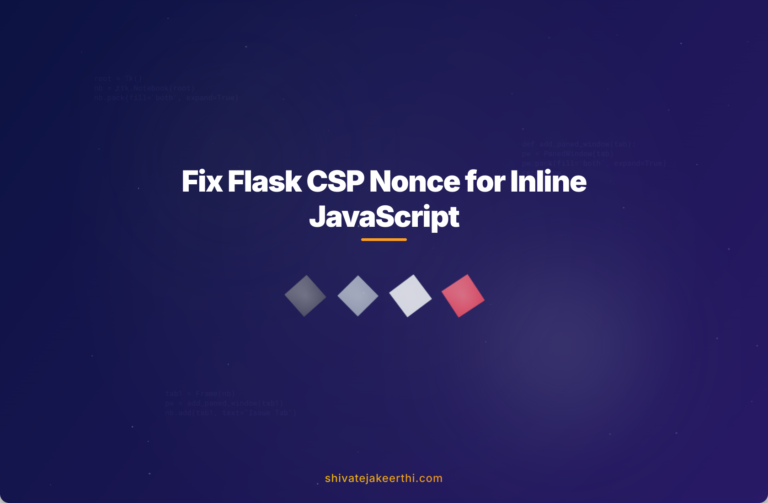If you’ve worked with Flask for a while, you probably encountered a scenario where inline JavaScript becomes a necessity. Flask’s handy url_for() function is a lifesaver for generating URLs dynamically, making your server-side code clean and efficient. But when you add inline scripts directly inside your HTML templates, modern browsers might start ignoring your scripts thanks to Content Security Policy (CSP) restrictions. It feels like hitting a brick wall. What’s going on here?
The Issue: Flask Automatically Adds CSP Nonce for Inline Scripts
When constructing your Flask application, it’s pretty common to inject server-side variables or dynamic URLs directly into inline JavaScript blocks. Here’s a simple example:
<script>
fetch("{{ url_for('get_data') }}")
.then(response => response.json())
.then(data => console.log(data));
</script>
This approach is straightforward and clear, but recent browser security standards make inline scripts tricky. Modern browsers heavily rely on Content Security Policy (CSP), which by default blocks inline scripts unless explicitly allowed.
To get around browser warnings or script blocking, you’ve likely looked into CSP settings. Usually, developers customize their CSP headers to allow inline scripts explicitly—typically by allowing ‘unsafe-inline’ or by using a specific nonce (a unique identifier generated per request). However, Flask automatically generates and includes its own nonce in the CSP header. This built-in behavior might conflict with your custom CSP setup, especially if you’re unaware it’s happening.
Creating a Content Security Policy in Flask
Setting a CSP header in Flask is a pretty straightforward process. For example, if you wanted a permissive policy initially, your CSP header might look like this:
response.headers['Content-Security-Policy'] = "default-src *; script-src * 'unsafe-inline' 'unsafe-eval'; object-src *; style-src * 'unsafe-inline';"
This permissive policy literally says: “allow everything—inline scripts, external scripts, even eval calls.” Despite this broad permission, you might still see issues with inline scripts failing. What gives?
Understanding the CSP Error in Your Browser
When your browser blocks scripts due to CSP, you’ll likely see an error similar to this one in your browser console:
Refused to execute inline script because it violates the following Content Security Policy directive...
Either the 'unsafe-inline' keyword or a nonce ('nonce-...') is required to enable inline execution.Confusingly, this error might persist even though you’ve explicitly included ‘unsafe-inline’. Examining your page source (Ctrl+U or right-click “View Page Source”) will show the inline script looking normal, yet the browser clearly isn’t happy. So why is it ignoring your directive?
Researching CSP and Browser Behavior
According to the Mozilla CSP documentation, browsers behave differently depending on combinations of CSP directives. One key takeaway: when a nonce is present for a given directive, browsers will ignore ‘unsafe-inline’, making it effectively useless in that case.
This means even if you’ve explicitly allowed ‘unsafe-inline’, the mere presence of a nonce (generated automatically by Flask) will trump ‘unsafe-inline’. This can become frustrating, leaving developers scratching their heads about why their CSP headers seem to fail inexplicably.
Why is Flask Adding an Automatic Nonce?
Flask includes built-in mechanisms to enhance security. Specifically, Flask extensions or certain built-in features may automatically inject CSP nonces to protect against potential cross-site scripting attacks (XSS). While the intention is excellent (increased security), it creates headaches if you rely on inline scripts but aren’t managing these nonces explicitly in your templates.
Surprisingly, Flask’s documentation is sparse regarding this automatic nonce insertion and how to disable or manage it—leaving many developers unsure how to navigate the issue.
Can You Disable Flask’s Automatic CSP Nonce?
Yes, fortunately, it’s possible—but the solution isn’t intuitive or well-documented. After scouring community resources like Stack Overflow on Flask CSP issues, a decent workaround exists.
Flask itself does not directly impose a nonce in standard installations. However, if you’re using extensions like Flask-Talisman that automatically manage Content Security Policies and other security headers, they might silently insert a nonce.
For example, using Flask-Talisman, the issue arises because this extension automatically adds nonces unless explicitly instructed not to. To disable automatic nonce generation in Flask-Talisman, you’d set:
from flask_talisman import Talisman
talisman = Talisman(app, content_security_policy={
'default-src': '*',
'script-src': ["'unsafe-inline'", "*"],
}, content_security_policy_nonce_in=[''])
This disables nonce insertion, enabling your inline scripts to finally adhere to a custom, flexible CSP.
Flask and CSP Compatibility—What Are Your Options?
Clearly, integrating modern CSP rules with Flask’s inline dynamic scripting practices (like leveraging url_for()) is challenging. Ideally, you’d want explicit control over your CSP—and if necessary, disable automatic nonce generation.
If you’re running into persistent issues, your choices typically are:
- Disabling automatic nonce: Adjust Flask-Talisman or related extensions to prevent automatic nonce insertion.
- Explicitly using nonce attributes yourself: Intentionally embedding nonce attributes in all your inline script tags.
- Switching to external scripts: Instead of inline scripts, serve your JS files statically. (However, this can complicate dynamic URL insertion.)
Each option has its trade-offs, but typically adjusting or disabling automatic nonce generation is most practical for developers heavily dependent on inline scripts.
A Quick Recap and Call for Advice
Dealing with CSP issues in Flask is certainly challenging. Inline scripts are historically convenient, yet modern security measures demand adapting approaches or explicitly controlling permissions. While Flask (and extensions like Flask-Talisman) aims to help bolster security automatically, this helpful behavior can strain your debugging patience enormously.
Given how often Flask developers depend on inline scripts, it’s puzzling why official documentation doesn’t explicitly handle this issue more clearly. If you have worked extensively with CSP and Flask and discovered practical ways to simplify this issue, feel free to share your insights or best practices. How are you managing CSP and inline scripts in your Flask apps?
Navigating intricate CSP issues can feel complex, but understanding these underlying conflicts and handling them head-on is the best way forward. Have you encountered this issue too? How did you solve Flask’s automatically generated nonce issues in your CSP workflow?



0 Comments